#jessica levine
For the past twenty years, artist, environmentalist, and educator Jessica Levine has strived to foster a relationship between nature and art. A graduate of the Pennsylvania Academy of Arts and winner of numerous awards, she uses her design skills and knowledge of local ecosystems to create a wide gamut of work, ranging from site-specific, large scale community art projects to smaller mixed-media assemblages. Whether the piece is a large pollinator garden or a small concrete sculpture, her artistic mission is the same: to inspire her viewers to a richer awareness of how deeply interconnected all members of the life-stream are.
As a part of our Urban Flow exhibition, Jessica built a sculptural installation piece entitled Urban Collapse Model, which is an artistic examination of a troubling environmental issue. She explains:
This sculptural installation is the fifth in a series in which I contemplate, in a somewhat lighthearted attempt, a serious matter: species extinction. Now that survival is threatened in a variety of groups— 25% of mammals and 40% of amphibians— the possibility of ecosystem collapse across the board, even in our verdant, beloved Appalachia, is very real… In this sculpture, I hope to create a sense of how, like nature, everything is growing and decaying, at the same time. And this is the connection to ‘urban flow’, the exhibition theme.
Materials in this sculpture include natural materials, some harvested on my farm, like sumac, grapevine and bamboo. The twine is from Brazil, and it’s dyed with black walnut hulls, so plentiful in the fall. I like to use recycled, reclaimed materials whenever possible and mix materials in unlikely ways. I strive to be a responsible partner in my ecosystem and remember that a basic guideline of biodiversity is interconnectedness.
Jessica installed Urban Collapse Model in our gallery space over the course of five hours, but you can watch the entire process from start to finish in this time-lapse video. See the sculpture in person by visiting us at TAMARACK: The Best of West Virginia during the month of February.
To see the rest of the sculpture series, visit Jessica’s website at www.jessicalevineartist.com
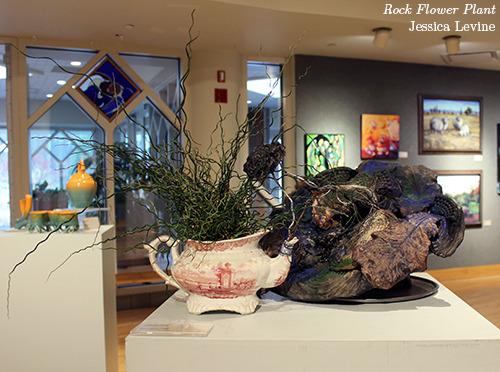
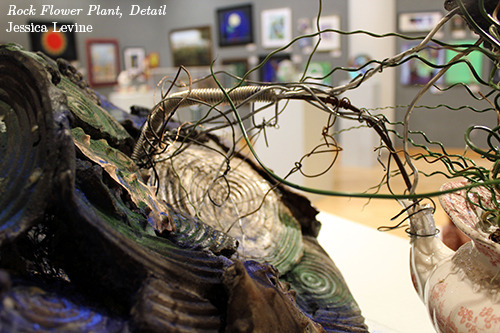


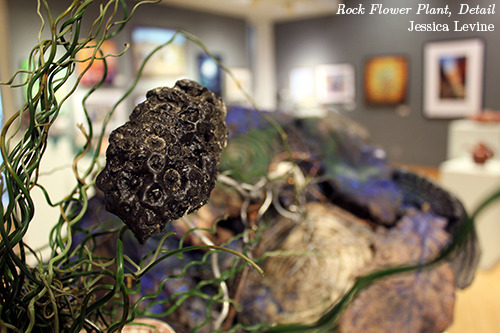
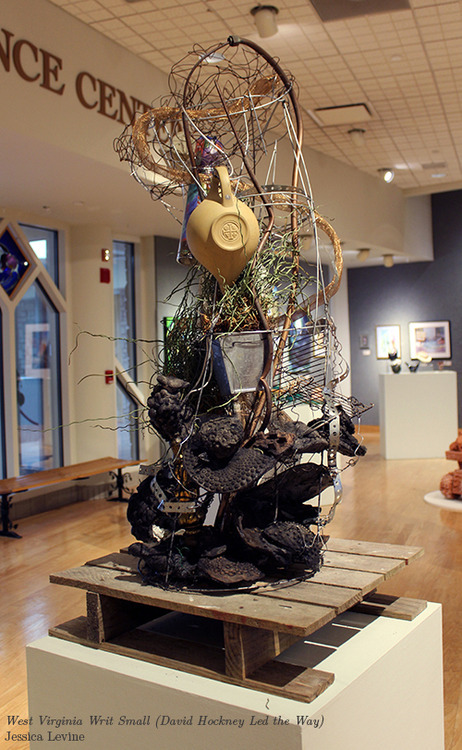
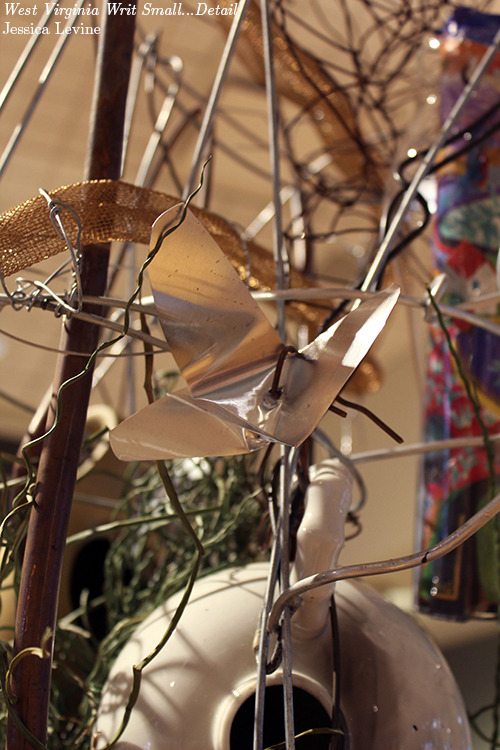
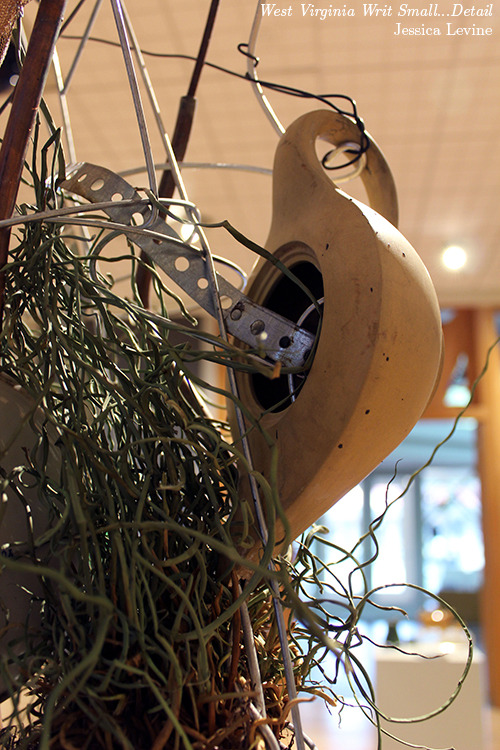
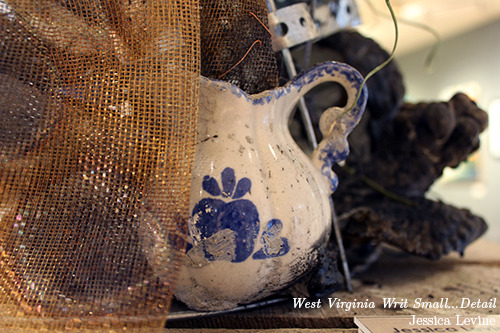

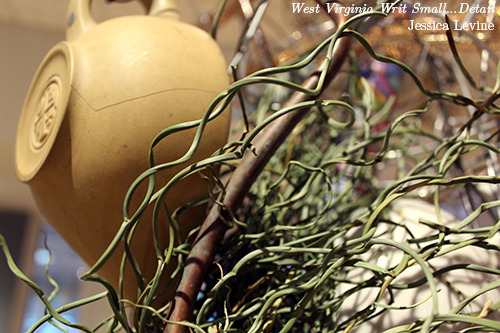
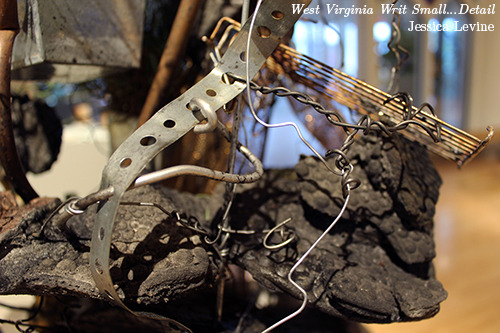
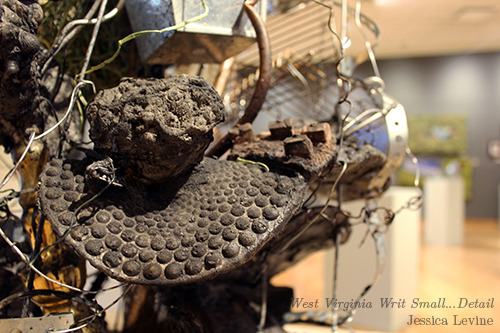
For the past twenty years, artist, environmentalist, and educator Jessica Levine has strived to foster a relationship between nature and art. A graduate of the Pennsylvania Academy of Arts and winner of numerous awards, she uses her design skills and knowledge of local ecosystems to create a wide gamut of work, ranging from site-specific, large scale community art projects to smaller mixed-media assemblages that she constructs in her studio. Whether the piece is a large pollinator garden or a small concrete sculpture, her artistic mission is the same: to inspire her viewers to a richer awareness of how deeply interconnected all members of the life-stream are.
To achieve this goal, Jessica shows us in a digestible format the intricacies of nature’s boundless visual information. This is especially true of her studio pieces, which in many ways serve as microcosmic studies for her broader mission. “Working at different scales feed back and forth from one another,” she explains. “I learn things from smaller pieces that can apply to large scale, longer term work. I [also] like working with a lot of different materials and textures. Some textures are detailed and small scale, which gets lost in a big piece that’s outdoors. They need a light room to really be impactful.”
Much of Jessica’s studio work might best described as thoughtful amalgamations. Utilizing various resources such as concrete casts, found objects, and organic matter, she explores the themes in nature she finds the most interesting and for her, the inspiration is endless.
I continue to be bowled over by nature as an artist. The textures and variety and imagination of form that you can witness is just overwhelming. [For example,] the way a leaf curls up and dries out can be just magnificent, and it is the most common object. How many leaves are out there lying on the ground? They’re everywhere, and yet they were living and they’re always changing… That’s something about the life force… something about being alive around other living forms that is very fascinating and intriguing. [There] is a pretty endless source of ideas brimming from that simple thing, and that’s what is interesting to me.
Currently, the gallery is featuring two of Jessica’s mixed media sculptures, each of which serves as an excellent representation of her ability to translate environmental properties into cohesive compositions. The thoughtful blend of living plants, found objects, and concrete casts in Rock Flower Plant for example, affords viewers the opportunity to see everyday objects and naturally occurring textures through a Fine Art lens. By putting these elements on a pedestal, she also brings attention to the relationship between naturally occurring objects and those made by man, a parallel that generally brings up feelings of discontent, but to Jessica, can also represent a certain harmony:
I’m intrigued by the relationship in nature to the objects we make. I’m interested in how humans make objects, and how machine made objects are like nature and yet not like nature. [For example,] things in nature tend not to be perfectly symmetrical, or not on the right angle, but not far off it either. I’m really interested in taking the factory made object and then distorting it so it looks more natural. [In Rock Flower Plant,] the bull’s-eye [motif] is a glass plate that I cast. I repeated the pattern in multiples and distorted the form each time so it looks like something in nature… It’s like bringing it back home.
Jessica’s other featured sculpture West Virginia Writ Small (David Hockney Led the Way) possesses similar aesthetic qualities as Rock Flower Plant, but tells a more personal story. Tall and twisting, West Virginia Writ Small is a tangle of wires, copper mesh, downturned teapots, and live plants. Her characteristic concrete casts also make an appearance, as well as a rolled up image of David Hockney’s painting LaurelCanyon, which is housed inside a glass lantern chimney. The sculpture, she tells us, is commemorative of a commute she used to make that made a big impact on her. She shared her story:
For many years, my studio was seven minutes from my house by car on a very windy West Virginia country road. Two cars could barely fit. I adore this road, Teaberry Road. It is really beautiful and has lots of hairpin turns, lots of elevation changes. When I would drive to my studio I would be in a reverie on my way. I would think of what I was working on when I was driving and I thought of the road as West Virginia “writ small” because it is a microcosm of our very mountainous beautiful state. It is like a ribbon and it would make me very happy to drive that road. I always wanted to incorporate it into a work of art.”
One day, I looked at the picture of David Hockney’s LaurelCanyon, which was hanging on my studio wall… and said, ‘aha, I’m working on [creating] Teaberry Road and this piece is inspiring me.’ I find that I’ve been studying art my whole life in a way…I look at [David Hockney’s] work and have taken ideas that have been in the field and have reworked them and explored them again and again.
Taking the time to decode the messages and motifs in Jessica’s work is a wonderful experience, as she encourages us through her art to explore the smaller parts of the larger picture. Each design and every object serves as a reminder of our enduring connection to our surroundings, which are always deserving of deeper exploration.
